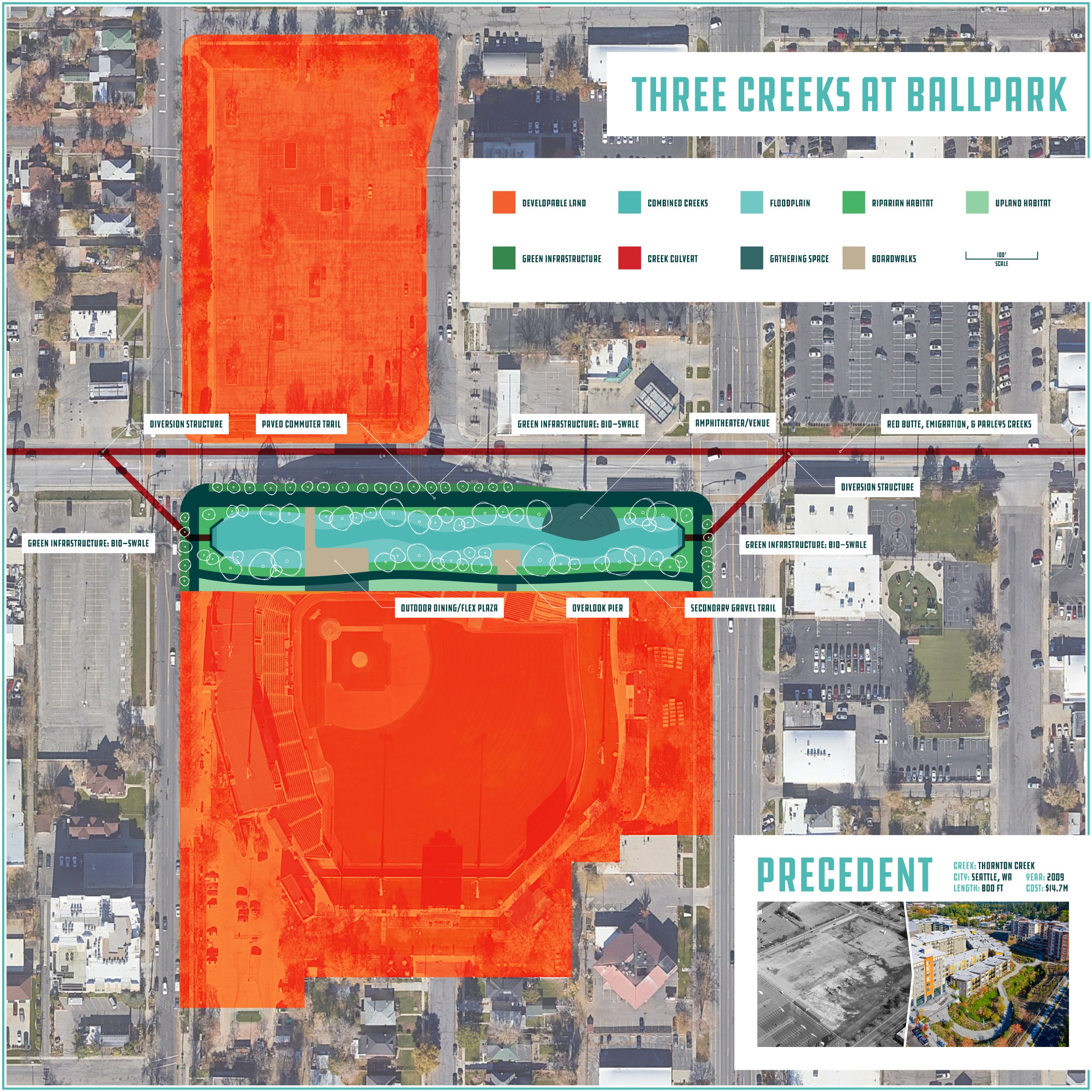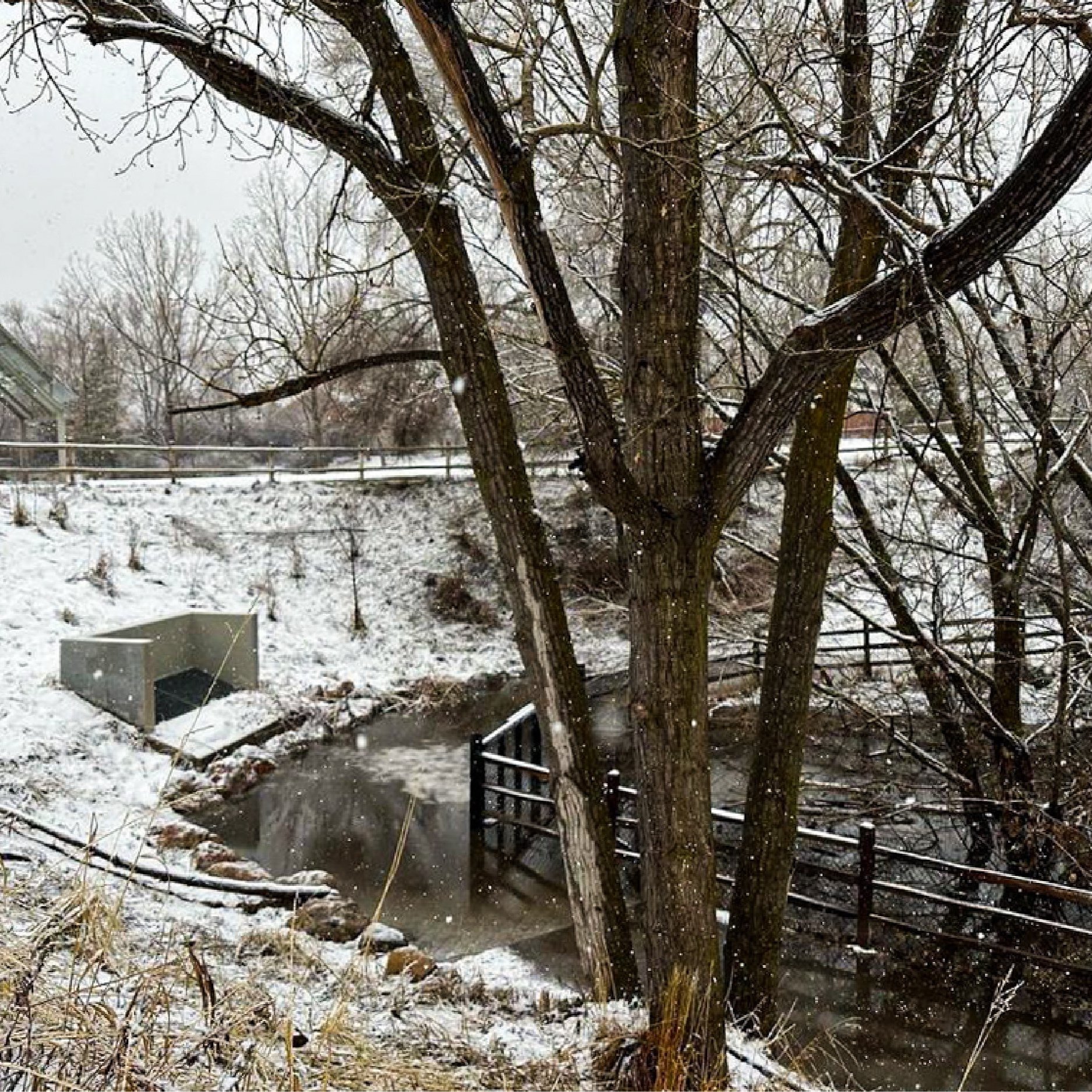Daylight the Three Creeks at Ballpark!
Authored by Brian Tonetti
Red Butte, Emigration, and Parleys Creeks flow underneath 1300 South—pass the Ballpark—to the Jordan River in Salt Lake City. The creeks should be uncovered in a greenway corridor to create a unique amenity and natural oasis in the heart of the Ballpark neighborhood. This is a once-in-a-lifetime opportunity!
Three of Salt Lake City’s urban creeks flow underneath 1300 South pass the Ballpark site on their way to the Jordan River—Red Butte, Emigration, and Parleys Creeks. As urbanization gripped the Salt Lake Valley at the turn of the 20th Century, creeks and green spaces gave way to asphalt and concrete. Salt Lake City contains over 14 miles of the buried stream channels of City, Red Butte, Emigration, and Parleys Creeks.
There continues to be a divide between the east and west-side of Salt Lake City. As creeks flow west, they flow underground into the stormwater system. All while, east-side residents enjoy exposed creeks as they flow through green spaces with trails, gathering spaces, and other amenities.
In 1995, Salt Lake City championed a new paradigm—one which prioritized the health of its waterways. City Creek was uncovered in a former surface parking lot at City Creek Park, an oasis in the heart of Downtown. Further solidifying this legacy, Red Butte, Emigration, and Parleys Creeks were uncovered at their confluence with the Jordan River. Opened in 2021, the $3-million Three Creeks Confluence educates residents about stewardship of our waterways in our oasis on desert’s edge, provides critical riparian habitat, and creates a gateway to the Jordan River for the surrounding neighborhood.
Daylighting Red Butte, Emigration, and Parleys Creeks at the Ballpark would continue this exciting legacy. With removal of the stadium, there is more than enough space to uncover the full flow of the three creeks along 1300 South by diverting the water from the existing culvert and keeping it in place. This would place the channel further below grade, which provides an opportunity for the channel to become a flood detention area. This would reduce pressure on the existing culvert during precipitation events. The Wasatch Hollow Emigration Creek detention basin provides a valuable precedent. The downstream culvert at the park is designed to fill up and overflow into three different levels, depending on water height.
The Three Creeks Confluence provides a valuable precedent for the Ballpark site. The 1.3-acre park includes 200 feet of restored stream channel, a 120-foot bridge to the Jordan River Trail, a 100-foot fishing bridge that includes 20 metal art pieces, a nature play space, and a plaza. Scaled to the potentially 700-foot-long channel at the Ballpark site with a 150-foot average right-of-way, this would be roughly 2.4 acres. The channel would only take up about 20% of the available Ballpark parcel (11 acres) to the south of 1300 South—plenty of additional space available for affordable housing, mixed-use development, and the many other goals of Salt Lake City.
Another precedent is Parleys Creek at the Intermountain Healthcare’s Memorial Clinic in the Sugar House neighborhood. While not a daylighting project, development has slowly encroached on the creek over the years. The channel shows the opportunity to have aboveground creeks in extremely confined urban environments. The creek and adjacent amenities, including a plaza and seating area, average about a 40-foot right-of-way. Scaled to 700 feet long, this is about 0.6 acres or about 5% of available space in the Ballpark parcel.
It is also possible to pump the water to the surface to reduce the depth of the creek, bringing it closer to the surface. This would reduce the flood detention capacity. However, it would allow for a greater channel slope for the water to move faster across the site. At the very least, the buried streams should be acknowledged on the site through creative placemaking, such as paint, signage, or other interpretative means.
According to the Salt Lake City Parks & Public Lands Needs Assessment, the Central Community, which contains the Ballpark, has the least access to parks and trails and is slated for the most future growth. This neighborhood has 2.8 acres of parks per 1,000 people, compared to 3.5 acres per 1,000 city-wide. An estimated 94 acres of new green space, throughout Salt Lake City, is required to meet future needs at the same level of service. Green space at the Ballpark would go a long way toward filling this critical need.
Ballpark was identified as one of the 21 opportunity areas in the Seven Greenways Vision Plan. The Plan envisioned “daylight[ing] Red Butte, Emigration, and Parleys creeks and increas[ing] the urban forest as Salt Lake City’s Ballpark neighborhood experiences growth and redevelops.” The creeks could meander among native riparian plantings, providing critical habitat value for the 80% of Utah’s wildlife that rely on these ecosystems. Access to nature is critical for our mental and physical well-being and childhood development. Green infrastructure, along the adjacent roads, could retain runoff and clean pollutants before collecting downstream and polluting the Jordan River. Increases in the urban forest would clean air pollutants and help cool the creeks and surrounding air temperatures to mitigate the urban heat island effect.
A paved commuter trail, on the north side of the creeks, could provide a direct connection along 1300 South. With additional bike lane improvements or a separated/off-street trail, efforts could connect Liberty Park to Ballpark to the Three Creeks Confluence along a greenway corridor, linking into the Jordan River Trail and 120-mile trail network along the Wasatch Front between Ogden and Provo.
Secondary nature trails could be place on the south side of the creeks. Bird and wildlife watchers could find solace in the natural surroundings. Art and placemaking, scattered through the site and within the natural environment, would create a unique juxtaposition and inviting pedestrian environment.
Stream daylighting can improve property values and stimulate surrounding economic development. Boardwalks, plazas, outdoor dining areas, and/or amphitheaters could provide community gathering space, areas for programming, venues for celebration, and spaces for local businesses. Affordable and mixed-income housing should be integrated throughout the site.








